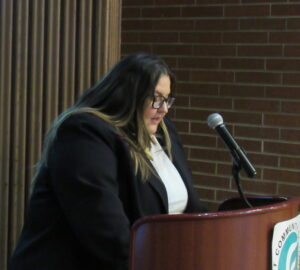By Harold C. Ford
Flint Community Schools (FCS) is taking preliminary steps toward an upgrade and reopening of its Flint Central High School campus, which was shuttered by the district in 2009.
With a unanimous 7-0 vote at its Jan. 22, 2025 meeting, the Flint Board of Education (FBOE) approved a contract with Plante Moran Realpoint (PMR) to begin preliminary work at a cost of $120,000, or $15,000 monthly over an eight-month period. PMR is a subsidiary of Plante Moran, a Detroit-based firm that has provided FCS consulting services for several years including advice about real estate matters.
A 20-page agreement between FCS and PMR entitled “Proposal for Schematic Design Oversight for Flint Community School District’s New Middle/High School Campus,” indicated the projected budget for the project “is currently $125 million” and PMR’s estimated overall fee will be $3.125 million.
Two major phases, funding details
The proposal provided sparse information about deadlines for steps leading to the reopening of the campus or an overall funding plan. However, it did note two major phases for the project.
The first phase, “Programming and Oversight,” includes capital planning and creation of a schematic design that lays out an architect’s work plan and design facilitation.
A more detailed second phase, “Owner Representation Services,” includes seven major components: project planning, project procurement, project monitoring and reporting, design, construction, activation assistance, and project close-out.
While specifics about overall funding of the projected $125 million rebuild were sparse, a few details in the “Schematic Design” document and commentary by FCS officials at the Jan. 22 meeting – namely by Superintendent Kevelin Jones and FBOE Vice President Laura MacIntyre – pointed to three sources of financing.
According to Jones, FCS itself will provide $70,000 of the initial PMR fee from the financially-challenged district’s “cash reserves.”
“We did not want the [Mott] Foundation to shoulder the brunt of the work,” he said.
The agreement and further commentary by FCS officials suggests that the Mott Foundation will provide the remaining $50,000 of the initial PMR fee and potentially more.
MacIntyre referenced “$50,000 from a foundation” and added, “I am now looking enthusiastically to the Mott Foundation to partner with us.”
Additionally, several references were made by FCS officials about “12(d)” funding, including a comment from Jones noting “we turned in our 12(d) application.”
Both 12(d) and 12(d)2 grants are provided by Michigan’s Department of Education for “infrastructure needs” to “eligible schools” that, among other criteria, have a “minimum percentage … of pupils in membership who were determined to be economically disadvantaged [and] are experiencing declining enrollment.”
“I’m very enthusiastic about this project … as it’s developed into this iteration,” said MacIntyre. “I am very excited … to see us trying to rectify some of the wrongs of the past.”
While MacIntyre did not explain what those “wrongs” were, she did note that she had been “such a large critic” of the Mott Foundation before. “I feel this is truly a partnership,” she added.
“The best of our schools … and the worst”
Prior to the FBOE’s unanimous vote of approval, nine members of the community commented on the proposal.
Many expressed concerns about preservation of the Central’s classic architecture, an expectant greater flow of traffic in the surrounding Central Park Neighborhood, and participation of residents in the planning process. Nonetheless, there seemed unanimous support for doing something with the property that has been abandoned for 15 years at 601 Crapo Street.
“As a resident and third-generation resident of the neighborhood, I have seen the best of our schools … and the worst when [buildings] were hastily left abandoned, unsecured, and eventually left to be scrapped and rotted over the past decade and a half,” said Nicholas Custer, a Central Park resident and EVM’s business manager.

Flint resident Samantha Farah speaks to the Flint Community Schools Board of Education at a meeting on Jan. 22, 2025. (Photo by Harold C. Ford)
While giving the upgrade and reopening his tentative support, Custer admonished that “iterations of this board … have seen the value of the cultural center but have not looked across the street at the value of the preexisting neighborhood.”
Other Flint residents expressed similar sentiment, with multiple commenters also pointing to the arts and culture offerings adjacent to the vacant campus, which include the Flint Institute of Music, multiple museums, Mott Community College, and the city’s recently remodeled library.
“[Central HS] is right next door to one of the best collections of cultural institutions in the nation and our community college – meaning that the opportunities for a great education are really limitless,” said Flint resident and Central Park property owner Derek Dohrman.
Other speakers expressed how important the decision was for Flint children and families.
“This is the next step … to tell the world, truly, that Flint Community Schools is here to stay, that there’s a future, that we’re not just going to be absorbed into a larger entity,” said Chad Schlosser, a Mott Park resident who ran for a FBOE position in the November 2024 election but lost out to Trustee Linda Boose. “We’re not just going to tell our kids to go find some other school, find some suburban school, or charter school.”
A long and winding road
The status of the abandoned Flint Central campus has been an object of speculation by FCS officials, the public, and others for more than a decade. Here is a timeline of some major events following its 2009 closure:
- 2013-2014: Before the Central-Whittier campus was finally closed and the buildings boarded up, Powers Catholic High School expressed an interest in acquiring the property. The proposal was flatly rejected by FCS. Subsequently, Powers relocated to a renovated Michigan School for the Deaf building at 1505 W. Court St.
- 2016: The FBOE released renderings by Flint-based THA Architects Engineers for construction of “new facilities” at the Flint Central campus for an estimated cost of $78.5 million. EVM reported that, “Residents of the nearby Central Park neighborhood expressed concerns about traffic and acts of vandalism that might accompany a new school at the site.”
- March 2017: In an interview with then-FCS Superintendent Bilal Tawaab, EVM reported that “2020 is the target date for the opening of a new, consolidated Flint high school at the location of the now-abandoned Flint Central High School campus … East Village residents in the neighborhoods surrounding the old Flint Central campus have … begun to express their concerns at community meetings about vehicular and student traffic, demolition of the old high school and middle school buildings and environmental safeguards, and funding for the project…”
- February 2021: A mixed-use redevelopment plan for the Central property was introduced from Georgia-based Harvard Group. EVM later reported that the plan “never got past the discussion phase.” In the same month, then-FCS Superintendent Anita Steward was admonished by some board members about her interactions with the Harvard Group over the long-abandoned campus.
- April 2021: EVM was first to report on a Memorandum of Understanding (MOU) involving 17 parties working on a “several hundred-million-dollar plan to rescue Flint Community Schools.” The plan included the construction of four new elementary schools and a new high school alongside the renovation of two other buildings. The plan was titled “Flint Education Continuum” (FEC) and was to be largely funded by the Mott Foundation. The MOU made clear that “all buildings would be operated by FCS and located within the City of Flint.” Following the MOU’s publication, some FBOE members suspected Steward of negotiating with the Mott Foundation without the participation of board members. Steward flatly denied the accusation and said that, “some members of the FBOE did not participate in the discussions when given the opportunity.”
- June 2021: Mott Foundation CEO Ridgway White appealed to the FBOE for positive consideration of the massive FEC plan for building all new schools in Flint. “That proposal has us committing to up to $200 million for Flint Community Schools,” he said.
- July 2021: In an exclusive interview with EVM, Steward said that, “Mr. White stated to me, ‘Anita, no strings attached, none. I just want to be able to do something for the school district. So, let’s sit down and have a conversation.’ And the conversations have involved board members. Board members have been invited to participate in these conversations. Some of them have elected not to attend the meetings.”
- October 2021: EVM reported that “the Flint Board of Education voted 6-0 to invite Mott Foundation CEO Ridgway White to visit and talk about the future of the long-abandoned Flint Central High School-Whittier Middle School campus.”
- February 2023: While news of the campus had largely disappeared from public view for 15 months, EVM reported that the FBOE had “voted unanimously to explore the possibility of reopening talks with the Flint-based Mott Foundation about the construction of new school building(s).”
- March 2023: FCS reveals a “Superintendent’s Proposed 6 Month Focus” document that briefly mentions “Mott Foundation and Partner support for possible new schools [and] moves in our own direction with the Central property by demolishing it.”
- January 2025: The FBOE voted unanimously to pay for the services of PMR, a consulting firm, as a preliminary step for developing a plan to rebuild and reoccupy the Flint Central campus.
Regardless of the winding road to the Jan. 22 vote, the audience present for it seemed overall supportive – and even hopeful – for the proposal’s outcome.
During her comments, Flint resident Samantha Farah added her voice to the echo of approval for the FBOE’s decision to renovate and reopen the long-vacant high school.
She said she was excited about the direction and the opportunity the district had to invest “in a cultural institution that has sat vacant and dormant for far too long,” calling the campus “centrally located” and “a cultural heartbeat of our city in many, many ways.”
This article also appears in East Village Magazine’s February 2025 issue.


You must be logged in to post a comment.